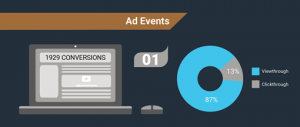Unsure about how your programmatic spending is being converted into media inventory? Columnist Grace Kaye breaks down the costs of a typical programmatic campaign so that you don’t have to be left in the dark.
 The question of where programmatic spend goes has stumped advertisers since the dawn of programmatic. I thought it was time to try to answer it, as simply as possible.
The question of where programmatic spend goes has stumped advertisers since the dawn of programmatic. I thought it was time to try to answer it, as simply as possible.
I’m sharing this partly in response to the recent headline that “60 percent of programmatic spend is wasted.” Undoubtedly there are campaigns out there where this is true; in fact, the percentage is probably greater in some cases. However, for a well-run campaign, this should never be the case.
Leaving aside ad misplacement, which I’ve already discussed at length in a previous article, let’s focus on the alleged inefficiency of the ever more complex supply chain of programmatic.
The process is not straightforward, but a good agency will make sure there is only so much complexity as is required to achieve the added benefits of programmatic: lower CPM, precise targeting, flexible management and a rich supply of data. Where there is complexity, a good agency ought to be able to explain it to their client and to account for its necessity.
In this article, I would like to show you how a typical spend is converted into media inventory. I hope this will be a useful insight into an area of advertising that has for too long been opaque.
I also hope it will provide some balance to an ongoing media narrative about the wastefulness of programmatic, which, for all of its issues, offers advertisers so much more than direct media buying ever could.
A typical programmatic campaign
Do keep in mind that programmatic campaigns are extremely variable, depending on the objectives of the client and the management style of the agency. There can’t really be a “typical” spend, but the example we have chosen is “normal” to the extent that there is nothing extreme in terms of the decisions that have been made by the agency.

For this example, the client has given the agency £100,000 to spend during the month.
Of this amount, £62,619 is spent on media inventory (for the less gifted mathematicians out there, that means approximately 37 percent is “wasted”).
What happens to the rest?
Some of the spend is needed to pay for DSP (demand-side platform) costs. Different agencies use different DSPs, so the costs will vary according to the platform, and also the size of the spend (there tend to be volume discounts). This example uses DoubleClick Bid Manager (DBM), part of Google’s DoubleClick suite, which for this campaign would be £8,454.
For my company, a one-DSP approach makes the most sense, as it allows us to optimize our use of it rather than searching for the best discount from multiple DSPs we may not fully understand. Other agencies may well use a different DSP, or a range of platforms.
There are also audience costs. One of the main perks of programmatic is that you can buy audience data, allowing you to target as microscopically as you desire. This comes at a price, in this case £8,620.
Audience data costs are one of the biggest variables. Certain data sets are more expensive than others; a big part of an agency’s job is choosing the most appropriate audience lists to maximize relevance and performance, while keeping within budget.
Ad serving costs are mandatory, and they are based on the number of impressions an ad receives. In this month, the spend is £1,947. However, there is an additional rich media fee (£3,505), as the client wanted to use HTML5 creatives, rather than a more basic display type. Once again, this is another variable; more sophisticated creatives means a higher charge to DCM (DoubleClick Campaign Manager).
An extra cost you might pay for is Adloox, a third-party tool used to minimize ad fraud and protect brand safety (£1,840). Considering the difference it makes in terms of minimizing ad misplacement (down to 0.3 percent in some cases), this is always well worth the extra cost.
On top of all of this, of course, a management fee needs to be applied. Taking an industry average of 15 percent, we apply this to all the costs listed above (rather than the initial figure of £100K), which amounts to £13,043 (hence the 13 percent of overall spend in the graphic above).
And there you have it. Not so complex, after all.
What happens next
What percentage of this is taken by the SSPs (supply-side platforms) is something we can’t speculate on, at least for now.
Hopefully, soon, SSPs will be forced into transparency anyway; let’s see how this Rubicon case progresses.
Programmatic is worth the costs
We use programmatic because it lets us be flexible in our management of a campaign, because of the trillions of data points it allows us to use for targeting and reporting, for its heightened performance, and for the range of inventory it gives us access to. All of these features are facilitated by ad-tech providers, hence the costs.
Critics of programmatic are good for the industry in general, because there is still a lot of cleaning up that needs to be done. But it’s important not to lose sight of the remarkable progress this mode of advertising represents, and to respect the fact that complexity is sometimes there for a reason.
The job of an agency is to keep things as simple as possible, and to make sure their client is never left in the dark about how the supply chain works. If your current agency can’t be transparent about this, or if they aren’t able to get close to this level of efficiency, then maybe it’s time to change partners.
Some opinions expressed in this article may be those of a guest author and not necessarily Marketing Land. Staff authors are listed here.
Marketing Land – Internet Marketing News, Strategies & Tips
(54)
Report Post







